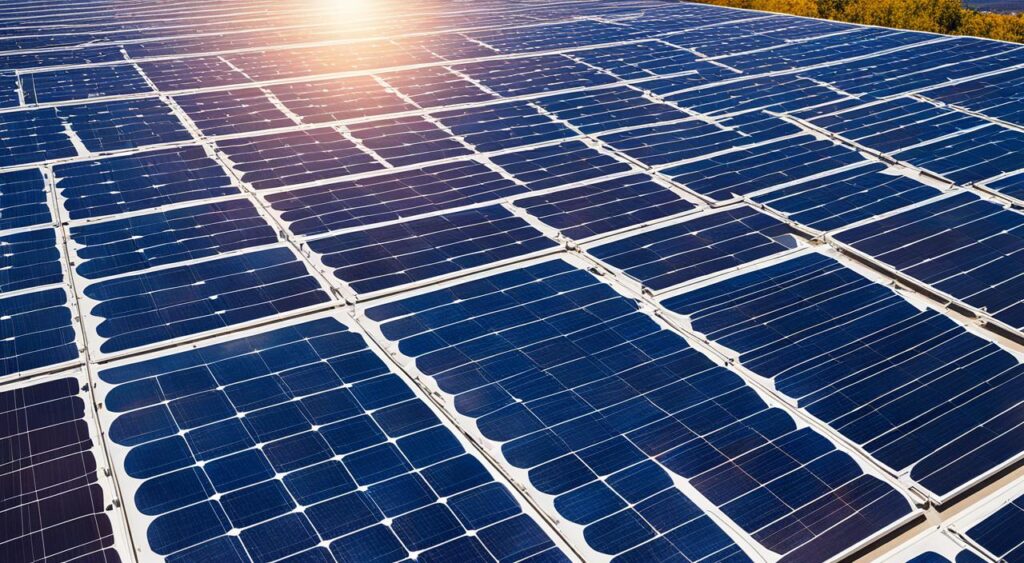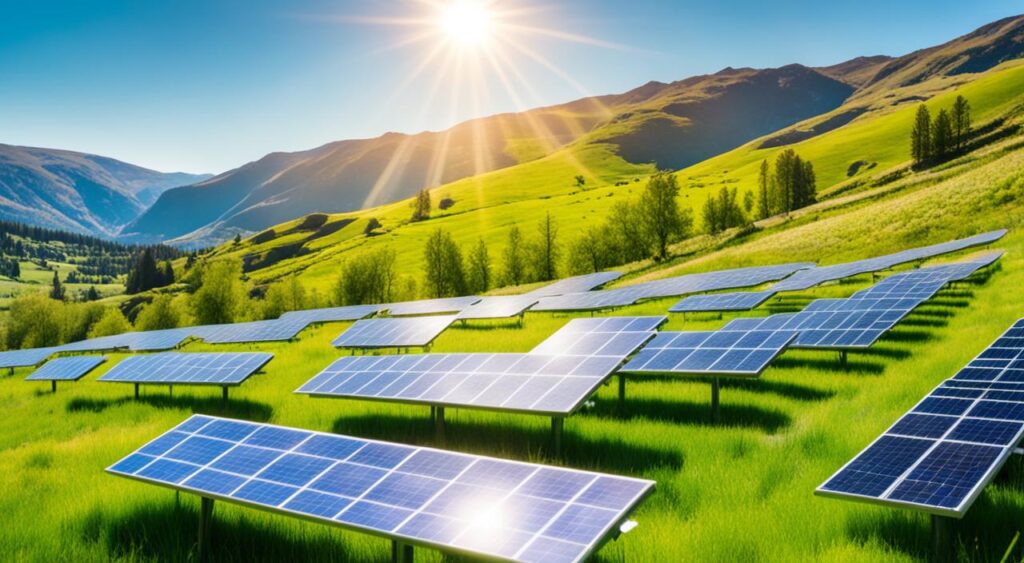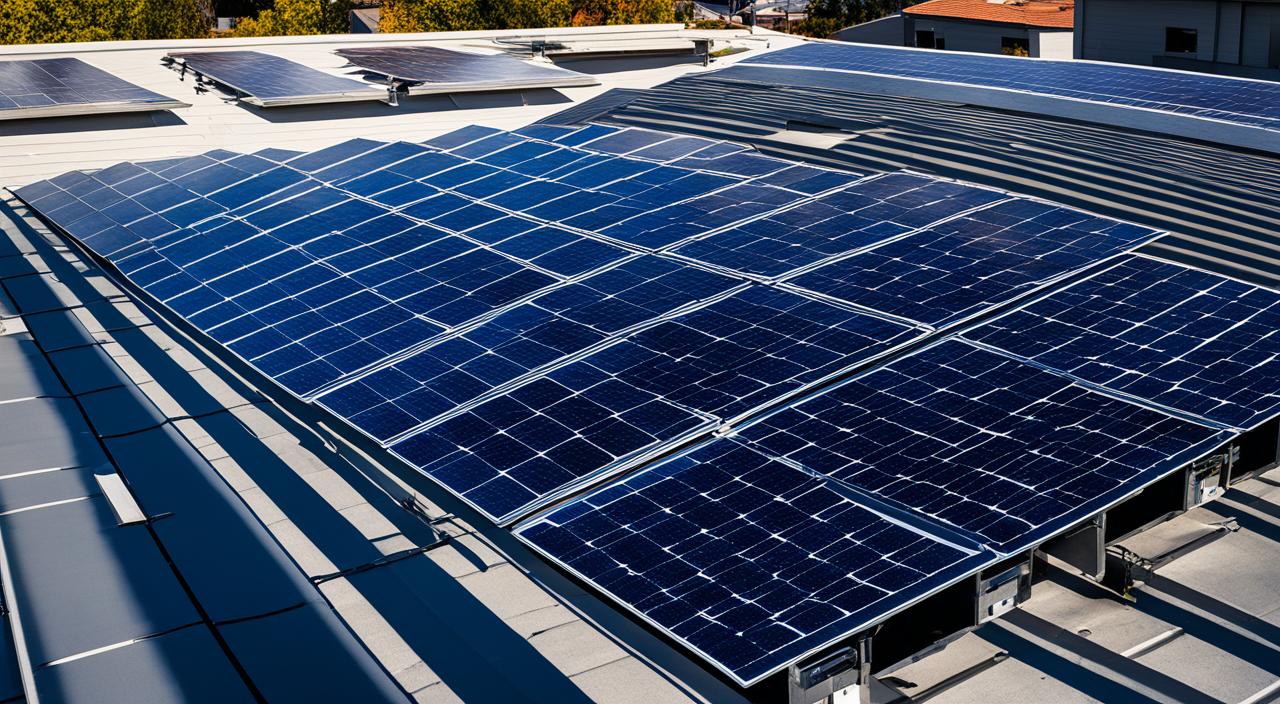Solar Power Facts
We’re moving towards a greener future, and solar power is key. It’s a clean, efficient, and affordable way to make electricity. This article will dive into solar power’s technology, its good for the planet, and how it’s used today and tomorrow.
Key Takeaways
- Solar power turns sunlight into electricity using photovoltaic technology.
- It’s good for the planet because it cuts down on greenhouse gases and uses less fossil fuels.
- Solar power works well in homes and businesses, saving money and giving energy freedom.
- There are incentives and rebates from governments and utilities to help people use solar power.
- New solar tech makes it more efficient, cheaper, and easier to get solar power.
What is Solar Power?
Solar power uses the sun’s energy to make electricity. It’s a clean, renewable way to power our homes and devices. At the core, photovoltaic technology changes sunlight into energy we can use.
Understanding Photovoltaic Technology
Photovoltaic (PV) technology turns sunlight into electricity using solar cells. These cells are made of silicon and catch the sun’s rays. They change sunlight into electrons, creating electricity for our daily needs.
The Science Behind Solar Energy Conversion
The science of solar energy is both simple and complex. When sunlight hits a solar cell, it makes electrons move. These electrons flow through a circuit, making electricity.
This renewable energy source cuts down on fossil fuel use. It’s a clean way to meet our energy needs. By exploring photovoltaic technology and solar energy conversion, we’re moving towards a sun-powered future.

“The sun, with all those planets revolving around it and dependent on it, can still ripen a bunch of grapes as if it had nothing else in the universe to do.”
– Galileo Galilei
The Environmental Benefits of Solar Power
We are working hard to make a future that is better for our planet. Solar power is a key part of this effort. It makes clean electricity without harming the environment. This helps us reduce pollution and keep our planet healthy.
Solar power is great because it can help reduce harmful gases in the air. Switching to solar means we use less dirty energy. This helps fight climate change and makes the air cleaner, which is good for everyone’s health.
Using solar power also helps save water. Traditional power plants use a lot of water, but solar doesn’t. This is good news for places that don’t have a lot of water. It means we can use water for other important things.

The solar industry also creates jobs and helps the economy. As more people use solar power, we need more experts to install and maintain it. This leads to more jobs and a stronger economy focused on renewable energy.
In summary, solar power is very good for the environment. It cuts down on harmful gases, makes the air and water cleaner, and helps the economy. Solar power is a big step towards a cleaner, greener future.
Solar Power Facts
The world is moving towards a sustainable future, and solar power is leading the way. Let’s explore some amazing stats and figures that show how far we’ve come with this green energy source.
Soaring Solar Capacity
As of 2022, the global solar power capacity has hit a huge 759 gigawatts (GW). This is a 22% jump from last year. It shows how fast solar power facts are changing the energy scene worldwide.
Remarkable Cost Reductions
Solar power costs have fallen a lot in the last ten years. Now, it’s cheaper for homes and businesses to use it. The price of solar panels has dropped by 90% since 2010, thanks to tech improvements and bigger production.
| Year | Average Solar Panel Price (per watt) |
|---|---|
| 2010 | $7.50 |
| 2022 | $0.75 |
These solar power facts and lower costs are why more people are choosing this green tech.
“The sun, as the ultimate source of energy for our planet, holds the key to a sustainable future. As we harness its power through solar technology, we are not only reducing our carbon footprint but also paving the way for a more resilient and self-sufficient energy landscape.”
These solar power facts show how far we’ve come and the big potential of this renewable energy. As we keep improving solar tech, the future of energy looks very bright.
Solar Panel Installation Process
Installing solar panels is a detailed process that requires careful planning. It starts with evaluating the site and designing the system. Then, it moves on to choosing the right mounting and wiring. Each step is vital for a successful solar power setup. Let’s explore the main parts of this process.
Site Evaluation and System Design
The first step is a detailed site evaluation. Our experts check the space, sun exposure, and any shadows. This helps us find the best spot and direction for the panels.
After evaluating the site, we design the solar system. We consider your energy needs, whether to mount on the roof or ground, and what parts you need. This makes sure the system fits your property and energy use perfectly.
Mounting and Wiring Considerations
Once the site and system are set, we look at mounting and wiring. Our technicians check the roof or ground to make sure it can hold the panels securely. This ensures a strong and lasting installation.
Wiring is also crucial. It connects the panels to the grid or a battery system. We pay close attention to make sure it’s safe and follows local rules.
| Key Factors in Solar Panel Installation | Description |
|---|---|
| Site Evaluation | Assessing the available space, sun exposure, and potential obstacles to determine the optimal placement of solar panels. |
| System Design | Customizing the solar power system based on energy needs, roof or ground-mounted configuration, and specific components required. |
| Mounting | Ensuring the structural integrity of the mounting surface for a secure and durable solar panel installation. |
| Wiring | Connecting the solar panels to the electrical grid or a battery storage system, while ensuring safety and compliance with regulations. |
By focusing on these key factors, we make sure the solar panel installation is smooth and effective. This leads to a greener energy future.
Residential Solar Power Systems
More homeowners are choosing residential solar power systems to power their homes. These systems help reduce your carbon footprint and save money on energy costs. When picking the right system, consider a few important factors.
Sizing and Selecting the Right System
First, figure out your energy needs. Look at how much energy you use each month and check your roof’s space for solar panels. This ensures your residential solar systems meet your energy needs and are a good investment.
After knowing your energy needs and roof space, pick the right system sizing and system selection. Look at different solar panels, inverters, and how they mount to your roof. Consider panel efficiency, warranty, and installation costs.
For the best residential solar systems, talk to a professional solar installer. They can help pick the best system for your home, considering your energy needs, space, and budget.
“Investing in a residential solar power system is an excellent way to reduce your carbon footprint and take control of your energy costs. With the right system sizing and selection, you can enjoy the benefits of clean, renewable energy for years to come.”
Think about system sizing and system selection carefully. This way, you can make a smart choice and move towards a sustainable, cost-effective energy future for your home.
Commercial and Industrial Solar Applications
Solar energy is more than just for homes. It’s also a big deal for businesses looking to cut costs and be more sustainable. Companies are turning to solar power to save money, be more independent, and meet green goals.
Many types of businesses use solar power, like offices, stores, hotels, and hospitals. This lets them pay less for electricity and help the planet. Commercial solar applications are a smart way for companies to manage their energy use and support a cleaner future.
In the industrial world, solar energy is changing how things are made and stored. Factories and big warehouses are using solar to save on energy costs and be kinder to the environment. Solar tech lets these big places use the sun’s power and lessen their need for old-school energy sources.
“Solar power is not just a residential solution; it’s a game-changer for businesses of all sizes and industries. The benefits are undeniable, from cost savings to enhanced sustainability.”
From busy offices to cutting-edge factories, solar energy is changing how businesses work. As more companies switch to solar, we’ll see new uses and a big shift in powering our work and industries.
The Costs of Solar Power
Installing solar panels is a big step, but it’s worth it in the long run. You need to look at both the initial costs and the savings over time when thinking about solar power.
Upfront Expenses
The first costs include buying and setting up solar panels, inverters, and other gear. These prices change a lot based on the system size, location, and technology type. But, solar power costs have been dropping, making solar more affordable for homes and businesses.
The average cost for a solar system in the U.S. is about $15,000 to $25,000 before any discounts. This is a big investment, but the savings over time can be worth it.
Long-Term Savings
Solar power offers big savings on your energy bills over the years. By making your own energy, you use less from the grid, saving money. Plus, many places offer incentives and tax credits to help with the upfront costs.
How much you save depends on your energy use, local rates, and system size. But, studies show homeowners can save thousands on bills over their system’s life.
“Investing in solar power is not just about reducing your environmental impact, but also about securing long-term financial stability for your home or business.”
Solar Rebates and Incentives
Homeowners and businesses in the United States can get rebates and incentives for solar power. These incentives help make solar energy cheaper and more accessible. They play a big role in encouraging people to use solar energy.
The federal solar tax credit, or Investment Tax Credit (ITC), is a key incentive. It lets people deduct a part of their solar panel costs from their taxes. In 2023, this credit is 30%, which helps save a lot of money.
- States and local governments also offer solar rebates and incentives. This adds more benefits to using solar energy.
- Some utilities have net metering programs. These programs give credits on electricity bills for the extra solar energy sent to the grid.
- Some states give property tax exemptions. This means the higher property value from solar doesn’t lead to higher taxes.
Many solar installers and providers help people understand solar incentives. They offer guidance and support. By using these incentives, people can lower the cost of solar power systems. This makes switching to renewable energy easier and cheaper.
| Solar Incentive | Description | Potential Savings |
|---|---|---|
| Federal Solar Tax Credit (ITC) | A federal tax credit that allows homeowners and businesses to deduct a percentage of the cost of their solar panel installation from their federal income taxes. | 30% of the total system cost in 2023 |
| State and Local Rebates | Many states and local governments offer their own solar rebates and incentives, further enhancing the financial benefits of going solar. | Varies by location, but can be significant |
| Net Metering | Some utilities provide net metering programs, which allow homeowners to receive credits on their electricity bills for the excess solar energy they generate and feed back into the grid. | Reduces electricity bills by offsetting the cost of grid-supplied electricity |
| Property Tax Exemptions | Some states offer property tax exemptions, ensuring that the increased property value from a solar installation does not result in higher taxes. | Varies by state, but can provide additional savings |
By using these solar rebates and incentives, people can lower the cost of solar power systems. This makes clean, renewable energy more affordable and accessible than ever before.
Energy Efficiency and Solar Power
Improving your home or building’s energy efficiency is key to getting the most from your solar power. This means your solar system will work better and save you more money. It’s a win-win for homeowners and businesses wanting to use renewable energy wisely.
Maximizing Your Solar Investment
Boosting energy efficiency is a wise move before getting solar power. It lets you use less energy, so you need a smaller solar system. This means you spend less upfront on your solar power investment. You’ll see your investment pay off faster and save more money over time.
Here are ways to make your solar power system work better:
- Upgrade to energy-efficient appliances and lighting
- Enhance insulation and weatherize your home or building
- Implement smart home technologies to optimize energy use
- Adopt energy-saving habits and behaviors
These steps cut down your energy needs. This lets your solar power system do its job better and more efficiently.
“Integrating energy efficiency and solar power is a powerful strategy for maximizing your renewable energy investment and achieving long-term cost savings.”
Together, energy efficiency and solar power create a greener, cheaper energy future. By focusing on both, you’ll get the best from your solar power investment.
The Future of Solar Technology
The solar power industry is growing fast, bringing new technologies and advancements. These changes are making solar power a key player in the energy world. With better solar cells and storage solutions, solar power could soon lead the global energy market.
Emerging Innovations and Advancements
Perovskite solar cells are a big deal in solar tech. They could be more efficient and cheaper than old solar panels. Researchers are also looking into tandem solar cells. These stack different materials to catch more sunlight, making solar systems better.
Advanced energy storage is another big step forward. Technologies like lithium-ion and flow batteries can store a lot of energy. This lets people use solar power even when the sun isn’t shining.
Artificial intelligence (AI) is changing how we manage solar power. AI systems use data to make solar panels work better and predict energy use. This makes solar power more reliable and efficient.
Looking ahead, better solar tech, storage, and smart grids will help us switch to clean energy faster. These changes will make our energy future sustainable and green.
| Emerging Solar Technology | Key Advancements |
|---|---|
| Perovskite Solar Cells | Higher efficiency, lower costs, and greater flexibility compared to traditional silicon-based solar panels |
| Tandem Solar Cells | Combine multiple layers of different photovoltaic materials to capture a broader spectrum of sunlight |
| Advanced Energy Storage | Lithium-ion batteries and flow batteries provide high-capacity, long-lasting storage solutions |
| AI and Machine Learning | Optimize and maintain solar systems by analyzing real-time data and adjusting performance |
The future of solar technology is full of solar innovations and solar advancements. These new technologies will change how we use energy. They will lead to a sustainable and green future.
Conclusion
This article has shown us the amazing facts and benefits of solar power. It’s a renewable energy source with huge potential for a sustainable future. We’ve looked at how photovoltaic technology works and the good things it does for the environment.
The future of solar power is full of new ideas and progress. New technologies are making solar power better and easier to get. This means we can fight climate change, save money, and be more independent from energy.
If you’re thinking about solar power for your home or business, now is the time. There are many ways you can help make the planet greener. Just start looking into solar power options near you and join others who want a better, eco-friendly future.

